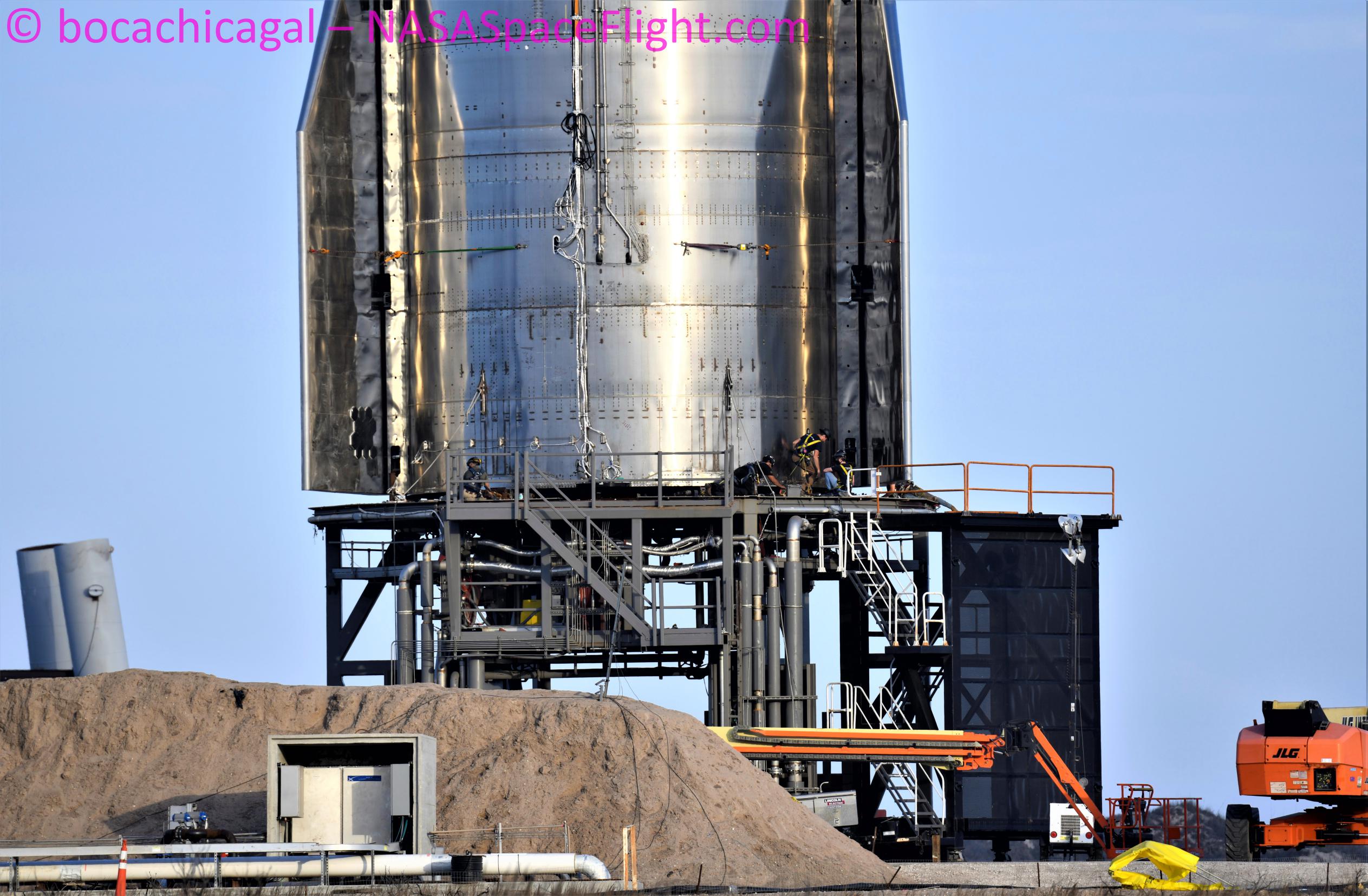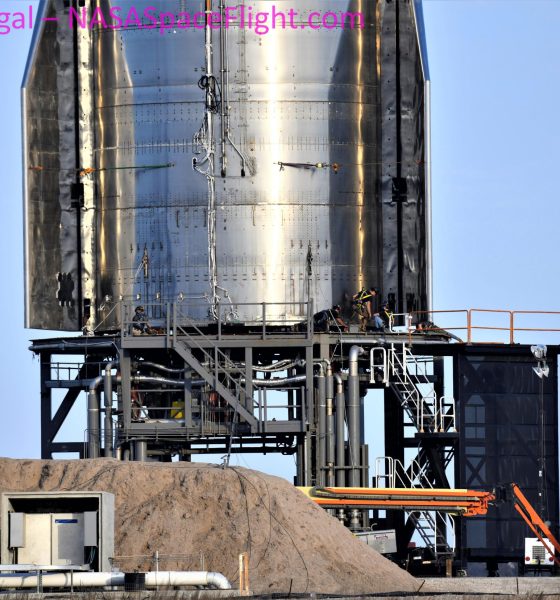

News
SpaceX Starship holds up under pressure, lines up Raptor engine test fire
After a few false starts and some minor delays, SpaceX’s 11th Starship prototype (SN11) has made it through two of the three major tests standing between it and liftoff.
SpaceX rolled Starship SN11 from the factory to the launch pad on March 8th, just five days after Starship SN10 briefly became the first prototype of its kind to land in one piece. One or two issues with Raptor’s final landing burn caused SN10 to touch down faster than expected and eventually led to the rocket’s explosive demise around 15 minutes later. Still, the test flight was an almost unequivocal success and seemingly left SpaceX with more than enough confidence to speed through preparations for the next flight test.
Heading into the next day, SpaceX had hoped to kick off cryogenic proof testing but Starship SN11 required a bit more attention than expected and unknown bugs ultimately meant that only an ambient-temperature pressure test could be completed by the end of the test window. Those issues appeared to persist through the end of March 10th, preventing any kind of proof test attempt.
On March 11th, Starship SN11 was able to take its first real stab at a cryo proof and was loaded with liquid nitrogen (LN2), a cryogenic fluid with a density and temperature similar to Starship’s liquid oxygen and methane propellant but without the risk of a catastrophic fire or explosion. Over the course of three or so hours, SpaceX didn’t appear to fully load SN11 with LN2, a possible sign of a technical bug that could just as easily be an intentional part of the test design.
Oddly, parts of the evenings testing were unlike past cryo proofs and there’s a slight chance that the activity was actually a static fire attempt scrubbed well before ignition, though it’s impossible to say without official confirmation.
Otherwise, the most notable part of the cryo proof was a test of Starship SN11’s attitude control system (ACS) that involved firing each of the ship’s several cold-gas nitrogen thrusters at least 5-10 times for a total of several dozen bursts. The current generation of Starships mainly use those thrusters to augment their flaps and perform flip maneuvers during suborbital launch and landing attempts, while early orbital-class prototypes may use the same thruster system to control their attitude in the vacuum of space.
If last night’s cryo proof test was successful and gave SpaceX the data it needs to give SN11 a good bill of health, the Starship could potentially attempt its first Raptor engine static fire as early Friday, March 12th. Historically, SpaceX has never static fired a Starship prototype less than 12 days after its launch site arrival, meaning that a static fire tomorrow would smash the previous record by a factor of three. As such, it’s more likely that SN11 will need a day or two and be ready for a static fire attempt as early as Monday, March 15th.
Either way, Starship SN11 is undeniably on a faster track than any of its three-engine predecessors and a clean static fire on Friday or Monday would leave a launch next week – SpaceX’s current target– well within reach.

News
Tesla FSD fleet is nearing 7 billion total miles, including 2.5 billion city miles
As can be seen on Tesla’s official FSD webpage, vehicles equipped with the system have now navigated over 6.99 billion miles.

Tesla’s Full Self-Driving (Supervised) fleet is closing in on almost 7 billion total miles driven, as per data posted by the company on its official FSD webpage.
These figures hint at the massive scale of data fueling Tesla’s rapid FSD improvements, which have been quite notable as of late.
FSD mileage milestones
As can be seen on Tesla’s official FSD webpage, vehicles equipped with the system have now navigated over 6.99 billion miles. Tesla owner and avid FSD tester Whole Mars Catalog also shared a screenshot indicating that from the nearly 7 billion miles traveled by the FSD fleet, more than 2.5 billion miles were driven inside cities.
City miles are particularly valuable for complex urban scenarios like unprotected turns, pedestrian interactions, and traffic lights. This is also the difference-maker for FSD, as only complex solutions, such as Waymo’s self-driving taxis, operate similarly on inner-city streets. And even then, incidents such as the San Francisco blackouts have proven challenging for sensor-rich vehicles like Waymos.
Tesla’s data edge
Tesla has a number of advantages in the autonomous vehicle sector, one of which is the size of its fleet and the number of vehicles training FSD on real-world roads. Tesla’s nearly 7 billion FSD miles then allow the company to roll out updates that make its vehicles behave like they are being driven by experienced drivers, even if they are operating on their own.
So notable are Tesla’s improvements to FSD that NVIDIA Director of Robotics Jim Fan, after experiencing FSD v14, noted that the system is the first AI that passes what he described as a “Physical Turing Test.”
“Despite knowing exactly how robot learning works, I still find it magical watching the steering wheel turn by itself. First it feels surreal, next it becomes routine. Then, like the smartphone, taking it away actively hurts. This is how humanity gets rewired and glued to god-like technologies,” Fan wrote in a post on X.
News
Tesla starts showing how FSD will change lives in Europe
Local officials tested the system on narrow country roads and were impressed by FSD’s smooth, human-like driving, with some calling the service a game-changer for everyday life in areas that are far from urban centers.

Tesla has launched Europe’s first public shuttle service using Full Self-Driving (Supervised) in the rural Eifelkreis Bitburg-Prüm region of Germany, demonstrating how the technology can restore independence and mobility for people who struggle with limited transport options.
Local officials tested the system on narrow country roads and were impressed by FSD’s smooth, human-like driving, with some calling the service a game-changer for everyday life in areas that are far from urban centers.
Officials see real impact on rural residents
Arzfeld Mayor Johannes Kuhl and District Administrator Andreas Kruppert personally tested the Tesla shuttle service. This allowed them to see just how well FSD navigated winding lanes and rural roads confidently. Kruppert said, “Autonomous driving sounds like science fiction to many, but we simply see here that it works totally well in rural regions too.” Kuhl, for his part, also noted that FSD “feels like a very experienced driver.”
The pilot complements the area’s “Citizen Bus” program, which provides on-demand rides for elderly residents who can no longer drive themselves. Tesla Europe shared a video of a demonstration of the service, highlighting how FSD gives people their freedom back, even in places where public transport is not as prevalent.
What the Ministry for Economic Affairs and Transport says
Rhineland-Palatinate’s Minister Daniela Schmitt supported the project, praising the collaboration that made this “first of its kind in Europe” possible. As per the ministry, the rural rollout for the service shows FSD’s potential beyond major cities, and it delivers tangible benefits like grocery runs, doctor visits, and social connections for isolated residents.
“Reliable and flexible mobility is especially vital in rural areas. With the launch of a shuttle service using self-driving vehicles (FSD supervised) by Tesla in the Eifelkreis Bitburg-Prüm, an innovative pilot project is now getting underway that complements local community bus services. It is the first project of its kind in Europe.
“The result is a real gain for rural mobility: greater accessibility, more flexibility and tangible benefits for everyday life. A strong signal for innovation, cooperation and future-oriented mobility beyond urban centers,” the ministry wrote in a LinkedIn post.
News
Tesla China quietly posts Robotaxi-related job listing
Tesla China is currently seeking a Low Voltage Electrical Engineer to work on circuit board design for the company’s autonomous vehicles.

Tesla has posted a new job listing in Shanghai explicitly tied to its Robotaxi program, fueling speculation that the company is preparing to launch its dedicated autonomous ride-hailing service in China.
As noted in the listing, Tesla China is currently seeking a Low Voltage Electrical Engineer to work on circuit board design for the company’s autonomous vehicles.
Robotaxi-specific role
The listing, which was shared on social media platform X by industry watcher @tslaming, suggested that Tesla China is looking to fill the role urgently. The job listing itself specifically mentions that the person hired for the role will be working on the Low Voltage Hardware team, which would design the circuit boards that would serve as the nervous system of the Robotaxi.
Key tasks for the role, as indicated in the job listing, include collaboration with PCB layout, firmware, mechanical, program management, and validation teams, among other responsibilities. The role is based in Shanghai.
China Robotaxi launch
China represents a massive potential market for robotaxis, with its dense urban centers and supportive policies in select cities. Tesla has limited permission to roll out FSD in the country, though despite this, its vehicles have been hailed as among the best in the market when it comes to autonomous features. So far, at least, it appears that China supports Tesla’s FSD and Robotaxi rollout.
This was hinted at in November, when Tesla brought the Cybercab to the 8th China International Import Expo (CIIE) in Shanghai, marking the first time that the autonomous two-seater was brought to the Asia-Pacific region. The vehicle, despite not having a release date in China, received a significant amount of interest among the event’s attendees.








